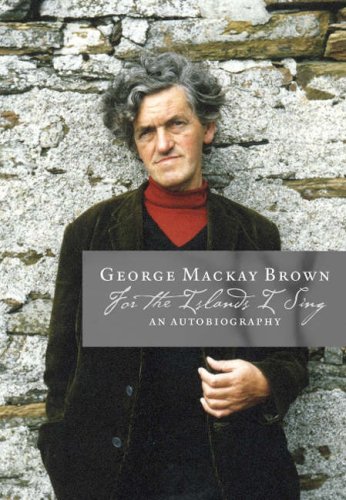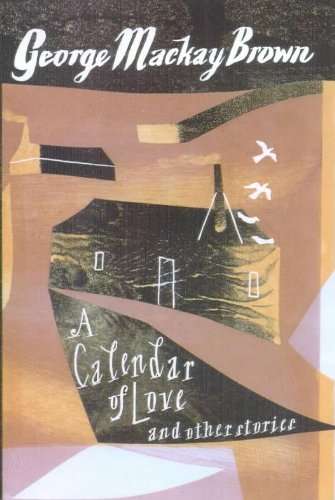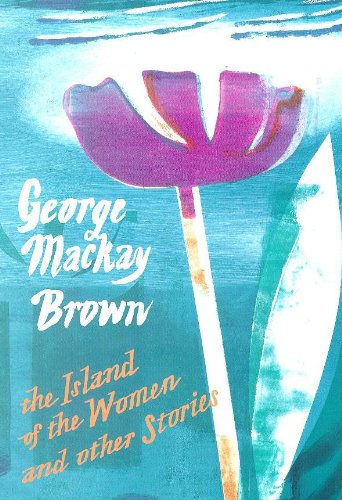
photo © Aurélien LE METAYER, 2007
by Carola Huttmann
George Macaky Brown
17 October 1921 – 13 April 1996
The Orkney Islands lie sixteen kilometres (ca. 8.64 nautical miles) off the northeast coast of mainland Scotland. Here, in the small harbour town of Stromness, the poet, short story writer and novelist George Mackay Brown was born into what he described in his autobiography, For the Islands I Sing, as ‘a poor family’. The youngest of six children, he rarely left his native islands. The only exceptions were his years of study – between 1951 and 1956 – when he was already an adult, first at Newbattle Abbey College in Dalkeith, near Edinburgh, then a year at Edinburgh University, from which he graduated with a Masters degree in English. His thesis examined the life and writings of poet and Jesuit priest Gerard Manley Hopkins.
The young Brown disliked school, viewing it as ‘a prison-house’. Perhaps, then, there is a certain irony in the fact that he first discovered his love of literature in the classroom. When his essays were consistently praised, he recognised that writing was something he was good at and the sense of pride it gave him was a welcome boost to his fragile self-confidence. It encouraged him to begin a magazine called The Celt, which was similar to the comics he would have been reading at the time. Largely concerned with news about football and containing stories he wrote himself, he distributed copies of it amongst his school friends.
From his late teens onwards, Brown was plagued by ill health. He suffered from bouts of depression at various periods throughout his life and, in 1941, at the age of twenty, was diagnosed with pulmonary tuberculosis. There followed several extended stays in Kirkwall’s Eastbank Sanatorium. Brown viewed his illness and those periods of confinement as ‘a kind of blessing in disguise’. They freed him from military service and from having to find gainful employment, but gave him plenty of time for reading and, during later spells there, also for writing. In his autobiography, he wrote that he counted the works of E. M. Forster, Dylan Thomas and George Orwell as being amongst the most significant influences upon his creativity.
 Brown was uncomfortable to find himself labelled a Modernist by the established Scottish writers of his day, such as Edwin Muir, Robert Rendall, Erik Linklater and Hugh MacDiarmid. According to his essay in Memoirs of a Modern Scotland, Brown mourned the vanishing traditions and values of the past as the rapid technological advances and progress accompanying the Modernist era appeared to leave people with little opportunity (or inclination) for evenings spent storytelling, reading poetry or making music with family and friends. At the same time he was alert to the fact that he stood on the border between two literary eras and, therefore, had a responsibility to his readers to look both behind him and act not only as a ‘preserver’ of history, but also to show curiosity about what was foreshadowed in the new ‘enlightened’ world of the twentieth century. Sabine Schmid, in her study of the writer and his work, Keeping the Sources Pure: The Making of George Mackay Brown, notes that he shared this desire with Edwin Muir who had established this notion himself in his first autobiography, The Story and the Fable. Schmid explains:
Brown was uncomfortable to find himself labelled a Modernist by the established Scottish writers of his day, such as Edwin Muir, Robert Rendall, Erik Linklater and Hugh MacDiarmid. According to his essay in Memoirs of a Modern Scotland, Brown mourned the vanishing traditions and values of the past as the rapid technological advances and progress accompanying the Modernist era appeared to leave people with little opportunity (or inclination) for evenings spent storytelling, reading poetry or making music with family and friends. At the same time he was alert to the fact that he stood on the border between two literary eras and, therefore, had a responsibility to his readers to look both behind him and act not only as a ‘preserver’ of history, but also to show curiosity about what was foreshadowed in the new ‘enlightened’ world of the twentieth century. Sabine Schmid, in her study of the writer and his work, Keeping the Sources Pure: The Making of George Mackay Brown, notes that he shared this desire with Edwin Muir who had established this notion himself in his first autobiography, The Story and the Fable. Schmid explains:
He thought that he and other twentieth-century writers belonged to a long line of writers who kept alive the ongoing tradition of storytelling and narrative. By taking the journey back through the centuries Brown contributed to this process, defining himself as the twentieth-century bard whose task was to maintain for the present and the future a sense of unity and order by being a ‘rememberer’ of those stories through which the Fable, or ‘the vision by which people live’ shines and by celebrating what he held to be enduring.
Today, Brown is considered to be one of the most important Scottish writers of his age and 2014 marked the sixtieth anniversary of his first publication, his collection The Storm and Other Poems. Besides poems Brown began writing articles and book reviews for the Orkney Herald and a literary magazine titled The New Shetlander. There also followed several short plays; the most well-known of which is ‘A Spell for Green Corn’ (1970). Later he went on to write a regular weekly opinion column, called ‘Under Brinkie’s Brae’, for The Orcadian newspaper, based in Kirkwall, Orkney’s main town.
Brown maintained a steady stream of poems throughout his life, but he also held a great affection for prose. His first collection of short stories appeared in 1967, under the title Calendar of Love and Other Stories. This was followed two years later by, arguably, his most popular anthology of stories and poems, An Orkney Tapestry. In total, he published ten volumes of short prose, the last of which, The Island of the Women and Other Stories, appeared posthumously, two years after his death. The seven other collections are: A Time to Keep (1969), Hawkfall (1974), The Sun’s Net (1976), Andrina and Other Stories (1983), The Masked Fisherman and Other Stories (1989), The Sea-King’s Daughter (1991), and Winter Tales (1995).
The history, landscape and natural rhythms of the Orkney Islands were Brown’s inspiration. Much of his work also shows influences of the Nordic sagas he loved, and of the strong storytelling traditions that were still popular during his childhood, but whose gradual decline he was later to lament in some of his critical essays. Most of his short stories concern themselves with one or more of these aspects. Often they are tales about ordinary folk living, working and interacting together in small communities. His superb skills of observation and gift for description seem to lift his characters off the page, so the reader almost feels they are occupying the same space, sharing the characters’ experiences.
The success of his first two volumes of short stories gave Brown the appetite to try his hand at a longer work, and in 1972 his first novel, Greenvoe, was published.
 The conversion to Catholicism, in 1961, released Brown from the dogma of his Calvinistic upbringing, which he had always resented, as noted in his autobiography. His new faith provided him with the ‘grounding’ and sense of purpose which, until then, he had been lacking. This, too, can be witnessed in his work.
The conversion to Catholicism, in 1961, released Brown from the dogma of his Calvinistic upbringing, which he had always resented, as noted in his autobiography. His new faith provided him with the ‘grounding’ and sense of purpose which, until then, he had been lacking. This, too, can be witnessed in his work.
Evidence of the liberation Brown felt his new faith provided can be seen in the way he uses religious references and symbolism in his storytelling. The life of St. Magnus (Magnus Erlendsson, first Earl of Orkney) is a topic he first addresses in his short story ‘Martyr’, contained in An Orkney Tapestry.
Saint Magnus, the island Earl, was a most outstanding man, tall, virile, with a vivacious expression, virtuous in his doings, lucky in war, wise, witty, quick with his tongue, noble-minded, generous, magnanimous councillor, extremely popular.
He was pleasant and courteous in his talk to good and well disposed men, but hard and pitiless to bandits and Vikings. He had those men put to deaths – harriers of freemen and the common people […] He let no bias influence his judgements; divine justice was more important to him than earthly rank.
Later, he devoted an entire novel to the subject.
In his short stories, Brown uses a huge range of different styles and techniques. They could be said to be the palette by which he developed his skills as a prose writer. Each new anthology builds on his previous ones. In Hawksfall, he experiments further with multiple viewpoint narratives, a literary device he had already begun to employ in Greenvoe. Also as in that novel, Brown continues, in this collection, to pepper his stories with references to ghosts, indicating his growing interest in the supernatural and the darker aspects of twentieth century life and society. In ‘The Drowned Rose’, for example, the ghosts of two dead lovers walk amongst the living enjoying the things and emotions of the ‘real’ world:
“The earth-bound soul refuses to acknowledge its death,” said Donald. “It is desperately in love with the things of this world — possessions, fame, lust. How, once it has tasted them, can it ever exist without them? Death is a negation of all that wonder and delight. It will not enter the dark door of the grave. It lurks, a ghost, round the places it fed on earthly joys. It spreads coldness about the abodes of the living.”
Archie Bevan and Brian Murray perfectly capture Brown’s writing style in their Introduction to The Collected Poems of George Mackay Brown:
 Brown’s prose carries a powerful emotional charge and is often deeply moving. It articulates the joy and grief, the suffering and endurance of his characters, many of whom are people of few words when it comes to voicing their feelings.
Brown’s prose carries a powerful emotional charge and is often deeply moving. It articulates the joy and grief, the suffering and endurance of his characters, many of whom are people of few words when it comes to voicing their feelings.
They go on to observe that Brown’s stories:
…often depict loss and suffering and despair, but are nevertheless imbued with a sense of ultimate serenity, an assurance that ‘all will be well and all manner of thing shall be well’.
Brown saw God’s presence in nature’s beauty and regarded its destruction as not only physically damaging, but also spiritually harmful.
The author makes his text work hard. His extraordinary gift for poetry and language gives his prose a great lyricism and charm. Every literary device he employs is symbolic of something else, something that is somehow relevant to modernism and life in his era, such as this extract from ‘Martyr’:
In a wholesome society the different estates are stitched together in a single garment: the warmth and comfort and well-being of the people, a symbol too of their identity and ethos. Their language, their work, their customs, all they think and do and say, decide the style and cut of the coat.
This view is as true and relevant to Norse times as it is today. The symbolism of the coat describes comfort, personal identity and social hierarchy and acts as a kind of camera lens onto life in every era of history. It is these qualities that make his stories timeless, whilst also fulfulling his objective of acting as a preserver of the past and a presager of things to come.
George Mackay Brown’s stories, novels and poems hold an uncanny power over me. There are many aspects of his outlook on life that equate with my own. I turn to his writing often. His exceptional capacity for observation, storytelling and putting complex sentiments into words have the ability to lighten even my darkest of moods. His death, in 1996, three days before St. Magnus day, the Saint he so much admired, deprived the literary world of one of the greatest writers of the twentieth century. His legacy, however, will live on forever; not only in his native Orkney Islands, but even in the farthest reaches of the world, where readers allow themselves to be entranced by the beguiling beauty of his writing voice.
~
 Carola Huttmann: Winner of the 2013 George Mackay Brown Fellowship short story prize, Carola Huttmann graduated just a day later with an MLITT in literature of the Scottish Highlands and Islands.
Carola Huttmann: Winner of the 2013 George Mackay Brown Fellowship short story prize, Carola Huttmann graduated just a day later with an MLITT in literature of the Scottish Highlands and Islands.
Passionate about all disciplines of writing she draws much of her creative inspiration from the richness of tradition, stories and history of the Orkney Islands which have been her home since 1995. Currently engaged in independent research, looking further at ideas explored in her dissertation – the gothic aspects in George Mackay Brown’s first novel Greenvoe (1972) – Carola is working on an academic monograph and a gothic novel set in Orkney.


One thought on “Profiling George Mackay Brown”
Comments are closed.